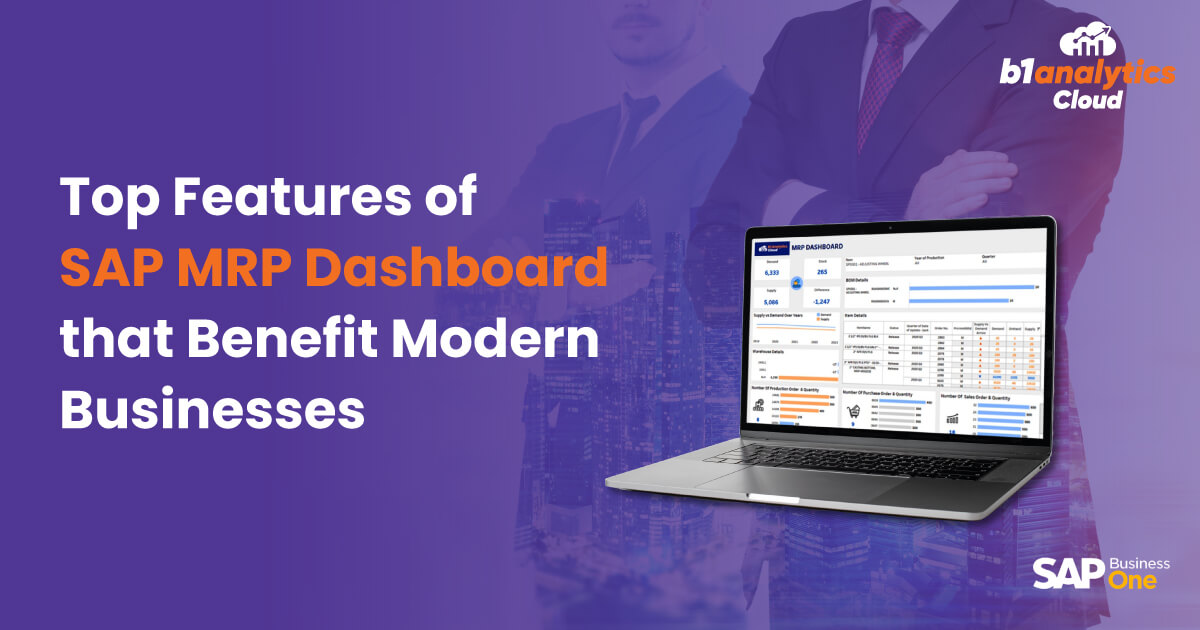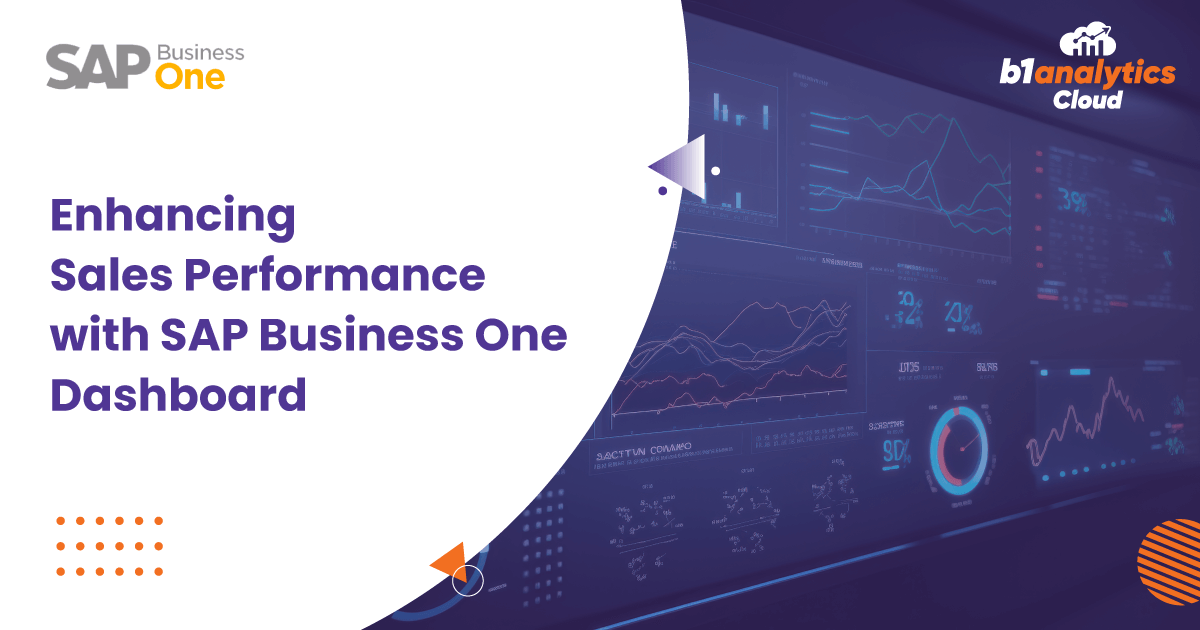The manufacturing sector is thriving at a rapid pace globally. However, manufacturers have to face stiff competition and other challenges in their journey toward growth. Here, efficient inventory management can play a crucial role. Advanced SAP MRP dashboard can assist modern manufacturing companies to meet this objective effectively.
In this post, we will see the top features and business benefits of SAP Business One dashboard dedicated to Material Requirements Planning or MRP. As a software-based system, MRP is designed to calculate both the materials and components necessary to produce a finished product. Let’s understand SAP Business One MRP dashboard before moving ahead.
Overview of SAP Business One MRP Dashboard
Material Requirements Planning or MRP is a vital tool that considers factors like BOM (Bills of Materials), production schedules, and existing levels of inventory. MRP can help companies get rid of overstock and understock situations. The SAP Business One MRP dashboard can take MRP to the next level.
MRP dashboard acts as a central hub for all your materials and their planning-related requirements. As a powerful visual interface in the SAP Business One, this dashboard is useful for providing users with real-time insights into critical inventory data. It is helpful in making informed decisions and optimizing the supply chain. Let’s have a close look at its core features.
Key Features of SAP MRP Dashboard
The SAP Business One MRP Dashboard offers a comprehensive suite of functionalities designed to empower the decision-making process and optimize inventory management. Some of its key features include-
1. Inventory Visualization
It gives users a real-time snapshot of your entire inventory at your fingertips. You can view current inventory levels for every item you stock across different categories like-
- Item- To see the exact quantity available for each item in your inventory.
- Warehouse- To gain insights into inventory distribution across different warehouses
- Inventory Type- To differentiate between raw materials, work-in-progress (WIP), and finished goods
This level of visualization empowers you to identify potential issues like understock or overstock situations. It can proactively address these situations by contributing in the prevention of production delays and optimzation of storage spaces.
2. Demand Forecasting
Predicting future needs is essential for efficient inventory management. The SAP MRP Dashboard integrates with your existing sales forecasts or historical data to generate demand forecasts. This feature helps you anticipate future needs for materials based on sales trends and historical sales data. You can get an accurate prediction for material requirements by leveraging past sales data.
The demand forecasting is beneficial in several ways. Manufacturers can plan production schedules effectively by ensuring the availability of the necessary materials. It is also useful in optimizing purchasing decisions as manufacturers can place puchase orders for materials in advance to avoid stockouts.
3. Production Planning
The true power of the MRP Dashboard lies in its ability to transform raw data into actionable insights. It seamlessly integrates information about current inventory levels including what materials you have on hand, with forecasts of future demand based on sales trends. This integration goes a step further by factoring in your bill of materials (BOM), which details the exact components needed for each finished product.
The dashboard generates intelligent production planning recommendations by considering all these elements. It eliminates the need for human calculations and guesswork. Instead, you receive clear direction on what and how much to produce, along with recommendations for purchase orders to ensure you have the right materials at the right time, guaranteeing a seamless and efficient production process.
4. Exception Management
Proactive problem-solving is key to maintaining a healthy inventory. The SAP Business One MRP Dashboard excels at identifying potential issues before they disrupt various operations. The exception management feature acts as an early warning system, highlighting situations like stockouts and excess inventory.
It assists manufacturers to take corrective actions like prioritizing orders for materials that are on the verge of stockouts and modify production schedules to avoid overstocking of specific materials.
5. Simulation of Different Scenarios
SAP offers a feature to simulate different planning scenarios along with predictive analysis. It enables manufacturing companies to evaluate the impact on the production by making changes in various aspects like price of raw materials and increase/decrease in demand. It offers a greater control over business operations and makes you ready for challenges.
It is fair to mention that all the features of the MRP dashboard in SAP B1 can increase efficiency, reduce costs, and improve inventory management.
Top Benefits of Using MRP Dashboard in SAP Business One
Features of the SAP MRP Dashboard give a range of business benefits that empower manufactuerers to streamline their inventory management processes and gain a competitive edge. Here are a few of them-
1. Improved Accuracy
Real-time inventory visualization and demand forecasting can help companies achieve optimal inventory levels. They can overcome the stockout situation by identifying low stock levels and minimize overstocking by monitoring excess inventory in advance.
2. Reduced Costs
The MRP Dashboard optimizes inventory management in several ways that results in significant cost reductions. Manufacturers can reduce carrying costs by minimizing overstocking and improve purchasing efficiency based on data-driven forecasts.
3. Enhanced Planning
The dashboard also empowers you to make informed decisions based on real-time data and insights. You can leverage the benefits of accurate production schedules and fulfill the customer’s orders on time. Moreover, proactive procurement enables you to anticipate demand for proactive purchasing.
4. Increased Efficiency
This dashboard automates several MRP tasks leading to significant time savings and streamlining your workflows. It facilitates you to eliminate manual calculations and improve collaboration with real-time data visibility. It acts as a common platform for procurement, production and sales.
Overall, the SAP Business One MRP Dashboard empowers manufacturers to optimize the entire supply chain, reduce costs, and make data-driven decisions that drive business growth.
Role of B1 Analytics in Leveraging SAP Business One Solution
In this data-driven world, B1 Analytics Cloud is your reliable partner to leverage the transformational power of data. As a leading advanced analytics solutions provider for SAP Business One, we help you make informed decisions and optimize processes based on real-time actionable insights. Our team of experienced and passionate professionals can provide unwavering support at every step so that you can make the most from a robust SAP B1 solution.
Concluding Lines
The SAP Business One dashboard for MRP has several features to assist manufacturing companies in managing inventory and supply chain. Manufacturers can easily avoid the situations like overstocking and stockouts with advanced features of the MRP dashboard. All they need to find the right SAP Partner to leverage the benefits of this dashboard and drive growth.

